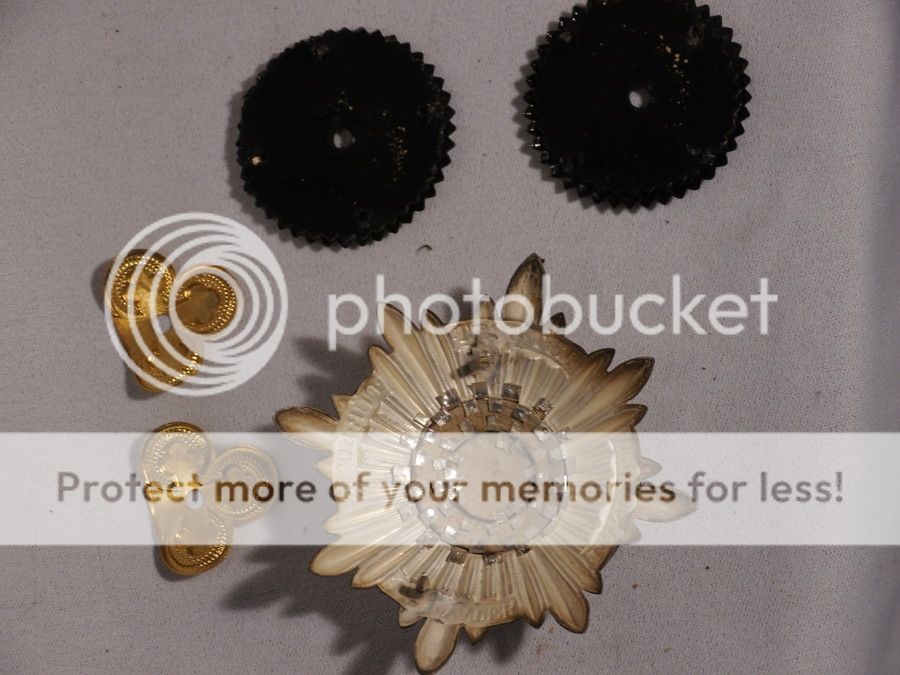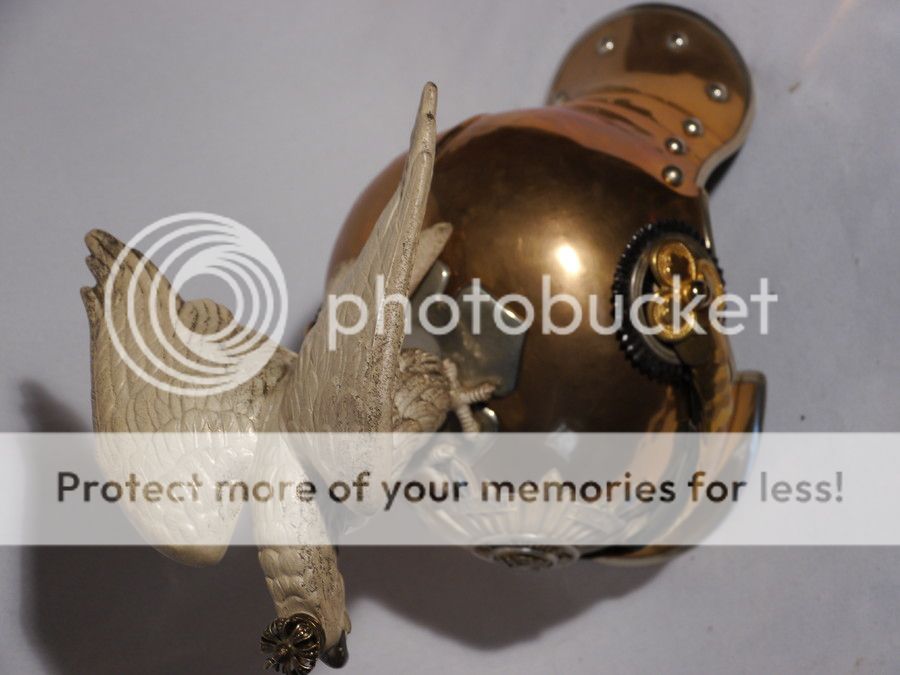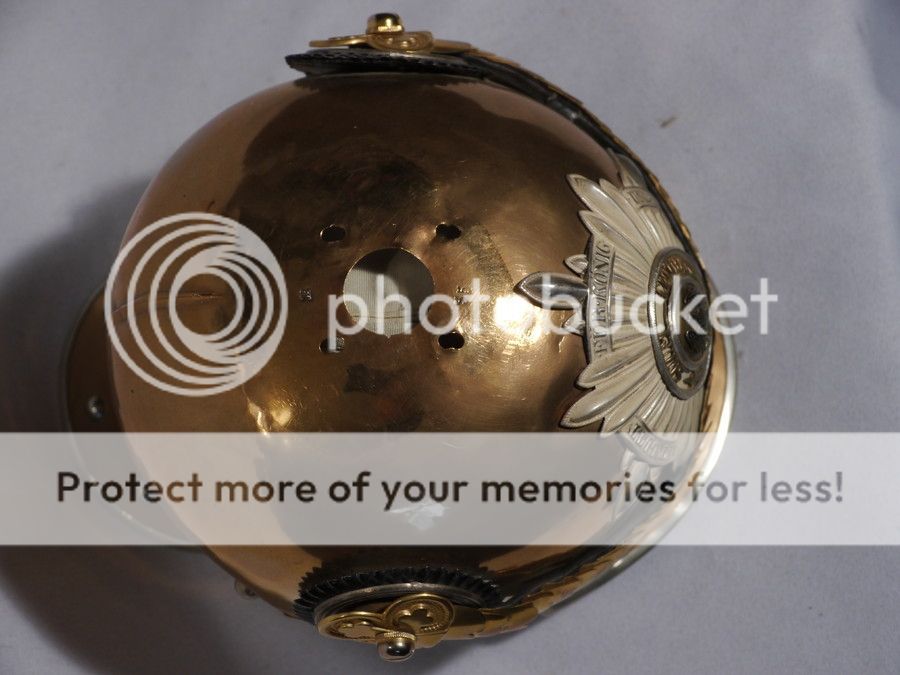skelts1974
New member
Hi everyone. This is the first time I have shared a find on this site. I recently completed purchasing all the parts needed for the restoration of my GdC Officer's Parade helmet and it is currently sitting in the workshop of Turner, Laughlin and Associates. I thought that I would share the restoration project here, starting with the helmet in its current state, then showing the completed item (a few weeks, months away yet). The journey began about six months ago when I spotted a helmet shell for sale on eBay from a seller who I have purchased a number of things from in the past. Seeing a once in a lifetime opportunity I snaffled the item up - much to the annoyance of my partner Helen. It is from there that the journey began.
While waiting for the shell to arrive I embarked on a quest to track down the required parts. I quickly brought a pair of officer kokardes from the UK (The seller had a pair of kokardes for a Saxon Garde helmet, I was after the National Kokardes only, but had to buy the pair as he was not prepared to split them). Unfortunately a week later I found the correct pair on a German Site and for a very reasonable price. I also picked up a set of trefoils and mounting screws / bolts from the same seller. Both purchases appear to have come from the same helmet. Interestingly, I had been told by an American dealer that he had not seen a matching pair of trefoils for sale in over twenty years of business. Guess he was not looking hard enough.
A few weeks later I identified a parade eagle in great condition. The German seller had a GdC helmet that had been restored in the past but had later been damaged and as a result was breaking it down to sell as a parts helmet. It took a few days to organise a deal where I obtained not only the eagle but also the GdC Officer's wrappen. By this time it was Christmas and Helen was more than a little annoyed at the amount of money I was spending (investing?!?) in this project. Apparently I loved the helmet more than her - words I am sure that others have heard in the past.
The original helmet shell had arrived by this time and I was fast putting the pieces together in my stash when the German seller who had sold me the Eagle and Wrappen offered up the accompanying helmet shell – a great example of a pattern 1907 Officer’s Parade helmet.
At this stage, having invested in all the other parts, I could not say no. The deal was struck and I started paying off a massive lay-buy debt (Helen by this stage was threatening murder, or at least maiming). During the final stages of the purchase I also scrounged up a second set of Trefoils (again from the same helmet – originals that have been re-plated).
Chin scales were a problem. While paying off the helmet shell several pairs of chin scales came on the market. Unfortunately I did not have the collateral to secure these. I had several pairs of Dragoon chin scales at home already. One set in good condition and the other covered with grime and missing parts. The solution was an easy one. Cameron from Turner, Laughlin and Associates recommended that we use my Dragoon sets to create the required chin scales for my GdC. A simple solution that has saved time and money. So win, win in my books.
With all parts assembled about a month ago I was just waiting for an opportunity to post the parts from Australia to America when I identified a silk liner and leather sweatband from a pickelhaube that would fit my helmet. Posting was delayed until I had secured the items (I was aiming for as close to possible a restoration using original period parts).
OK so here we go. Take a look at the photos and watch the restoration take shape.
Regards
Steve
While waiting for the shell to arrive I embarked on a quest to track down the required parts. I quickly brought a pair of officer kokardes from the UK (The seller had a pair of kokardes for a Saxon Garde helmet, I was after the National Kokardes only, but had to buy the pair as he was not prepared to split them). Unfortunately a week later I found the correct pair on a German Site and for a very reasonable price. I also picked up a set of trefoils and mounting screws / bolts from the same seller. Both purchases appear to have come from the same helmet. Interestingly, I had been told by an American dealer that he had not seen a matching pair of trefoils for sale in over twenty years of business. Guess he was not looking hard enough.
A few weeks later I identified a parade eagle in great condition. The German seller had a GdC helmet that had been restored in the past but had later been damaged and as a result was breaking it down to sell as a parts helmet. It took a few days to organise a deal where I obtained not only the eagle but also the GdC Officer's wrappen. By this time it was Christmas and Helen was more than a little annoyed at the amount of money I was spending (investing?!?) in this project. Apparently I loved the helmet more than her - words I am sure that others have heard in the past.
The original helmet shell had arrived by this time and I was fast putting the pieces together in my stash when the German seller who had sold me the Eagle and Wrappen offered up the accompanying helmet shell – a great example of a pattern 1907 Officer’s Parade helmet.
At this stage, having invested in all the other parts, I could not say no. The deal was struck and I started paying off a massive lay-buy debt (Helen by this stage was threatening murder, or at least maiming). During the final stages of the purchase I also scrounged up a second set of Trefoils (again from the same helmet – originals that have been re-plated).
Chin scales were a problem. While paying off the helmet shell several pairs of chin scales came on the market. Unfortunately I did not have the collateral to secure these. I had several pairs of Dragoon chin scales at home already. One set in good condition and the other covered with grime and missing parts. The solution was an easy one. Cameron from Turner, Laughlin and Associates recommended that we use my Dragoon sets to create the required chin scales for my GdC. A simple solution that has saved time and money. So win, win in my books.
With all parts assembled about a month ago I was just waiting for an opportunity to post the parts from Australia to America when I identified a silk liner and leather sweatband from a pickelhaube that would fit my helmet. Posting was delayed until I had secured the items (I was aiming for as close to possible a restoration using original period parts).
OK so here we go. Take a look at the photos and watch the restoration take shape.
Regards
Steve



